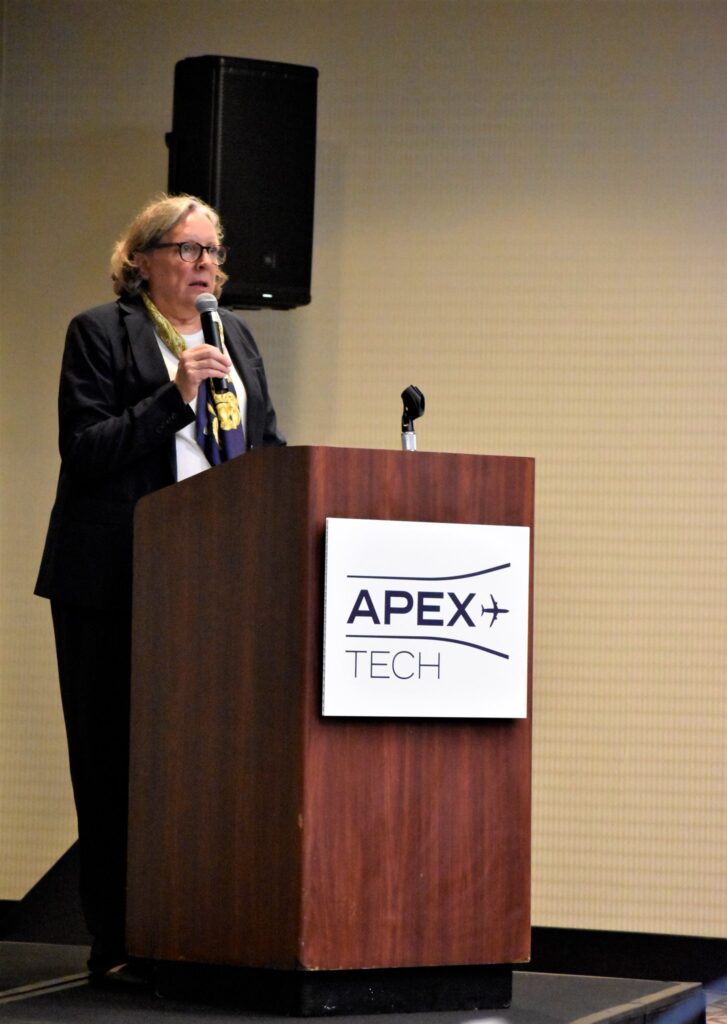APEX TECH: NetForecast’s Mary Rogozinski talks IFC partnerships and the role of the integrator
Share
APEX TECH: Day One – NetForecast Director of Aviation, Mary Rogozinski moderates lively ‘New Constellations, New Partnerships, New Players’ panel at APEX TECH
Partnership was the word at a post-lunch panel discussion moderated by veteran TECH committee member, NetForecast’s Mary Rogozinski at APEX TECH 2023.

The panel featured Simon McLellan, Vice President/Chief Engineer, Research & Development, Anuvu; Scott Rees, Senior Director of Operations – Connectivity, Panasonic; Floris Reimbold, Senior Manager Business Development, AERQ; Todd Hill, Senior Manager, Technical Product Management, Telesat ; and Nicholas Charron, Director of Strategic Partnerships & Business Development – Connectivity, Thales.
Rogozinski opened the session by unveiling a meticulously organized chart highlighting 30 known or anticipated IFC partnerships.
Drafted up by longtime APEX TECH member, American Airlines’ Erik Miller – Rogozinski explained that Miller was very proud of his chart, which, she said he was quick to point out, was not the “definitive chart.”
Following the first slide up with an even more intricate, Miller-crafted chart that she dubbed “the web,” Rogozinski discussed the many ways that IFC partnerships – like those that encompass multiple orbit satellite services or those between satellite service providers and equipment manufacturers – are shaking up the IFC space at present.
Rogozinski then invited her panelists to speak specifically to the airline members in attendance about their unique experiences with partnerships.
After a quick overview of each panelist’s company partnerships the discussion steered towards why partnerships are so attractive to airlines.
First and foremost airlines prefer someone that can work on different networks so they don’t get stuck with someone who’s not performing. The second reason for the industry-wide embrace of IFC partnerships is that although there are a lot of really good systems out there, none, or very few of them, have the whole package airlines want.
Another equally important facet to any meaningful discussion of IFC partnerships, noted Rogozinski, is the role of the integrator as a single point of contact for the airlines.
Not simply to add accountability or, as Panasonic’s Rees joked, “one neck to choke,” but also to handle the added complexity that partnerships often entail.
“The role of the integrator is really important in any of these models,” noted Rees. “So it’s no longer just how well are you managing your own products that your company is making but how are you working well with the other partners that you rely on?”
Flexibility is also key, added Hill from Telesat, who offered airlines the final word on the subject with some sage advice.
“I’ll just say one piece of advice to an airline who’s doing an RFP,” said Hill. “Buy an antenna that works with multiple service providers and own the IP so that you can modify it to get a different service provider. So you don’t have to replace primary structure installations.
“Within the big scheme of things, not to dismiss it, swapping out a modem is easy. It’s a secondary structure. Swapping out an antenna, brutally hard! Something about primary structures and tracks and airflow over control surfaces, the FAA gets all excited about it. I don’t know why!”


